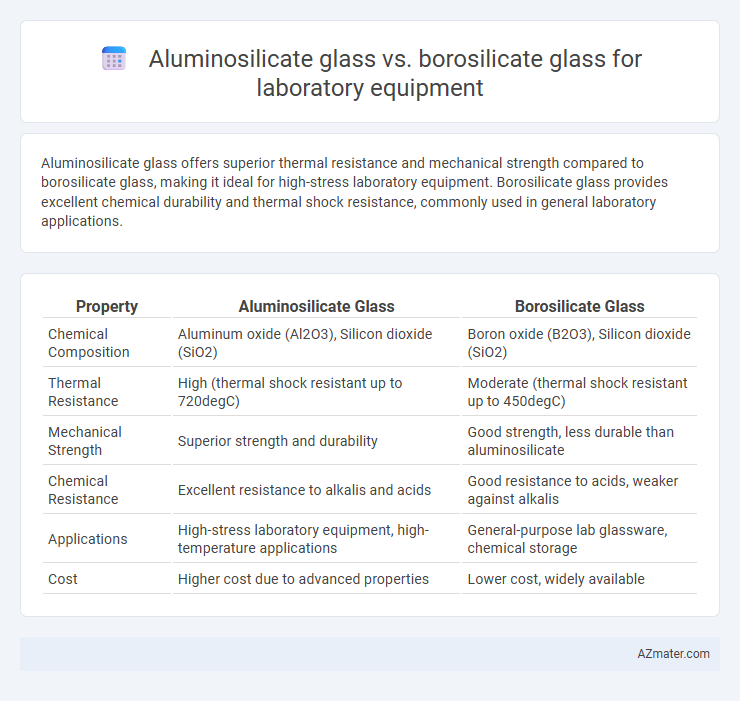Aluminosilicate glass offers superior thermal resistance and mechanical strength compared to borosilicate glass, making it ideal for high-stress laboratory equipment. Borosilicate glass provides excellent chemical durability and thermal shock resistance, commonly used in general laboratory applications.
Table of Comparison
| Property | Aluminosilicate Glass | Borosilicate Glass |
|---|---|---|
| Chemical Composition | Aluminum oxide (Al2O3), Silicon dioxide (SiO2) | Boron oxide (B2O3), Silicon dioxide (SiO2) |
| Thermal Resistance | High (thermal shock resistant up to 720degC) | Moderate (thermal shock resistant up to 450degC) |
| Mechanical Strength | Superior strength and durability | Good strength, less durable than aluminosilicate |
| Chemical Resistance | Excellent resistance to alkalis and acids | Good resistance to acids, weaker against alkalis |
| Applications | High-stress laboratory equipment, high-temperature applications | General-purpose lab glassware, chemical storage |
| Cost | Higher cost due to advanced properties | Lower cost, widely available |
Introduction to Laboratory Glassware Materials
Aluminosilicate glass offers superior thermal shock resistance and enhanced chemical durability compared to borosilicate glass, making it ideal for high-stress laboratory applications involving rapid temperature changes and aggressive chemicals. Borosilicate glass, composed primarily of silica and boron trioxide, provides excellent resistance to heat and chemical corrosion, widely used in routine labware like beakers and flasks. The choice between aluminosilicate and borosilicate glass depends on the specific laboratory requirements, including thermal stability, chemical resistance, and mechanical strength.
Aluminosilicate Glass: Composition and Properties
Aluminosilicate glass, primarily composed of aluminum oxide (Al2O3) and silicon dioxide (SiO2), exhibits superior thermal resistance and mechanical strength compared to borosilicate glass, making it ideal for high-stress laboratory environments. Its composition enables enhanced chemical durability and lower thermal expansion coefficients, reducing the risk of breakage during rapid temperature changes. These properties make aluminosilicate glass preferable for laboratory equipment subjected to extreme temperature fluctuations and mechanical impact.
Borosilicate Glass: Composition and Properties
Borosilicate glass, primarily composed of silica (SiO2) and boron trioxide (B2O3), exhibits exceptional thermal resistance and chemical durability, making it ideal for laboratory equipment. Its low coefficient of thermal expansion (about 3.3 x 10-6 /degC) ensures resistance to thermal shock, outperforming aluminosilicate glass in temperature fluctuation scenarios. Borosilicate glass also demonstrates excellent resistance to acids, alkalis, and solvents, maintaining clarity and integrity during rigorous experimental procedures.
Thermal Resistance: Aluminosilicate vs Borosilicate
Aluminosilicate glass offers superior thermal resistance compared to borosilicate glass, with a higher softening point around 1650degC versus approximately 820degC for borosilicate. This enhanced thermal stability allows aluminosilicate glass to withstand rapid temperature changes and thermal shock more effectively, making it ideal for high-temperature laboratory applications. Borosilicate glass, while durable and resistant to chemical corrosion, is more suited to moderate thermal conditions where extreme heat resistance is not critical.
Chemical Durability in Laboratory Environments
Aluminosilicate glass exhibits superior chemical durability compared to borosilicate glass, offering enhanced resistance to alkalis, acids, and thermal shock in demanding laboratory environments. Its high alumina content provides increased strength and reduced ion exchange, minimizing surface degradation during chemical exposure. Borosilicate glass, while still chemically resistant, is more prone to alkali attack and surface corrosion under prolonged exposure to harsh reagents, making aluminosilicate the preferred choice for aggressive chemical handling and high-stress applications.
Mechanical Strength and Impact Resistance
Aluminosilicate glass possesses higher mechanical strength and superior impact resistance compared to borosilicate glass, making it ideal for laboratory equipment subjected to rigorous handling and thermal stress. Its enhanced durability stems from the aluminum oxide content, which reinforces the glass matrix, providing better resilience against cracking and shattering. In contrast, borosilicate glass, while chemically stable and heat resistant, typically exhibits lower toughness and is more prone to breakage under mechanical shocks.
Price and Availability Comparison
Aluminosilicate glass typically costs more than borosilicate glass due to its enhanced thermal and mechanical properties, making it ideal for high-stress laboratory applications. Borosilicate glass remains more widely available and affordable, dominating the market for general-purpose lab equipment such as beakers and flasks. The broader supply chain for borosilicate glass ensures faster procurement and lower overall expenses compared to the more specialized aluminosilicate glass.
Common Laboratory Applications for Each Glass Type
Aluminosilicate glass is ideal for laboratory applications requiring high mechanical strength and thermal shock resistance, such as in high-pressure reactors and burner tubes. Borosilicate glass is commonly used for chemical glassware like beakers, flasks, and condensers due to its excellent chemical durability and thermal resistance. Both glass types are essential in laboratories but are selected based on specific application needs like temperature tolerance and chemical exposure.
Safety Considerations and Breakage Risks
Aluminosilicate glass offers superior thermal shock resistance and higher mechanical strength compared to borosilicate glass, making it less prone to breakage under sudden temperature changes in laboratory settings. Borosilicate glass, while chemically resistant and suitable for many applications, is more susceptible to fracturing when exposed to rapid thermal cycling or mechanical stress. Selecting aluminosilicate glass enhances safety by reducing breakage risks and potential chemical exposure during experiments requiring frequent heating and cooling.
Choosing the Right Glass for Your Laboratory Needs
Aluminosilicate glass offers exceptional thermal shock resistance and mechanical strength, making it ideal for high-stress laboratory applications requiring durability and frequent heating. Borosilicate glass excels in chemical resistance and thermal stability, suited for general-purpose labware and experiments involving corrosive substances. Selecting the right glass depends on specific lab needs: choose aluminosilicate glass for enhanced durability under thermal and mechanical stress, or borosilicate glass for superior chemical resistance and versatility.

Infographic: Aluminosilicate glass vs Borosilicate glass for Laboratory equipment
 azmater.com
azmater.com